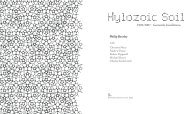The Inner Studio - Riverside Architectural Press
The Inner Studio - Riverside Architectural Press
The Inner Studio - Riverside Architectural Press
You also want an ePaper? Increase the reach of your titles
YUMPU automatically turns print PDFs into web optimized ePapers that Google loves.
PART THREE | INNER RESOURCES<br />
safe functioning, is to satisfy needs that are less easily expressed,<br />
such as comfort and an emotional sense of belonging–perhaps even<br />
the capacity to inspire hope and creativity. It seems natural to bring<br />
our bodies’ innate capacity to create and express to the design<br />
process because it is the body, with its extraordinary sense and<br />
range of touch, that we are actually seeking to contact and satisfy.<br />
Embedded in the way society now lives is a set of beliefs that<br />
strongly impacts architectural design, a set of beliefs that overvalues<br />
thinking and underestimates the potential of the body to<br />
invoke imagination, arouse decision making, and guide the creative<br />
process. Modern life involves us in machine-like living. Our<br />
dependence on pervasive mechanical and automated systems turns<br />
all natural systems, including our bodies, into a liability. Unlike<br />
machines, however, our bodies will not always perform according<br />
to our wishes or keep up with all that we hope to accomplish.<br />
Instead of rejecting what our bodies are trying to tell us because<br />
they are prone to fatigue, sickness, and bouts of unreliability, we<br />
need to become conscious of our vulnerabilities so they can be<br />
included in the world. Precisely because our bodies are imperfect,<br />
they offer a unique perspective for understanding the relationship<br />
between the built world and ourselves.<br />
In fact, our bodies provide places that our emotions and souls<br />
can call home, and the range of feelings that we experience through<br />
the body not only civilizes, but ultimately and fundamentally<br />
humanizes, the way we live, work, and think.<br />
Psychologically speaking, the body is associated with the<br />
unconscious because in our daily lives we are simply not conscious<br />
of its functioning or its wisdom. <strong>The</strong> way my eyes actually process<br />
visual data, the way my spleen regulates sugar levels, the way my<br />
digestive system processes food–these complex operations take<br />
place below the threshold of awareness. Our sense of sight does not<br />
require conscious involvement. I have never been involved in<br />
supervising the functioning of my glandular system or the electrical<br />
pulsations that become thoughts or movements. <strong>The</strong>re is an innate,<br />
instinctive intelligence at work on our behalf. We usually only<br />
notice the body when it has a complaint; otherwise, we are happy<br />
to not center ourselves there because to do so would compromise<br />
55





